Can you freeze green beans? Yes, you can…and they taste amazing! Learn how to freeze green beans in no time with this easy step by step tutorial!

One of the ways that I save quite a bit of money on groceries is by preserving lots of fruits and vegetables.
While we live in the city and don’t have room for a big garden, we’re blessed to live in an area where we can get lots of beautiful, homegrown produce for great prices. So I simply buy large amounts from local growers and then preserve them for us to enjoy all year long.
I know that canning and freezing produce sounds really daunting to many people, so I’ve done a number of step by step canning and freezing tutorials to show you just how simple the process really is.
Today I’m going to show you how to freeze green beans. Not only are they super easy to preserve by freezing, they also taste so much better than store-bought!
In fact, recently I saw a great deal on some frozen beans at the store and decided to buy a couple of bags thinking it would help stretch our supply since I hadn’t frozen as many this year as I probably should have.
I made them for dinner and after one bite my husband commented, “It’s no wonder so many people don’t like vegetables!”
And I had to agree. They just were nowhere near as tasty as the green beans that I freeze!
The benefits of freezing green beans vs. canning them
There are affiliate links in this post. As an Amazon Associate, I earn from qualifying purchases. Please read my full disclosure policy.
You can preserve your beans by canning or freezing them. If you choose to can them, you need to use a pressure canner since using a regular canner doesn’t reach high enough temps to kill the bacteria that causes botulism.
I find the pressure canning process rather time-consuming and tedious plus it also makes the beans less nutritious. Did you know that frozen veggies and fruit have almost as much nutritional value as when they are fresh?
So, I prefer to simply freeze our green beans. And once you see how amazingly easy it is to do, I think you’ll understand why!
Supplies for freezing green beans
- Dishpan or container to put the beans in
- Paring Knife (love this one!)
– You can also use your fingers to do this, but I find it harder and it doesn’t look as nice either. - Blancher
– You can use a big pot instead but it gets a bit complicated when it comes time to drain the beans and cool them quickly
(Don’t have a blancher and don’t want to buy one? See if you can find a friend that has one that you could borrow.) - Freezer bags or freezer-safe containers to store the beans
– I like using these freezer boxes.
How to Freeze Green Beans
1. Trim the bean ends
Remove the ends of the beans and any defective spots. If you have true “string” beans, remove the strings too.
Technically you don’t have to remove the tail end of the bean, just the end that was attached to the stalk. However, I don’t like the look of leaving them on so I remove them too.
2. Cut the beans into smaller pieces
Break or cut the beans into 1 to 1 ½ inch pieces.
If you have children, this is a step that even little children can help with. In fact, they often think it is fun!
3. Wash the beans.
Wash the beans thoroughly in cold water. I like to put a dishpan full of beans in my sink and then just fill it with water.
Swish the beans around really well to work any dirt loose.
4. Fill the blancher’s colander
Move the beans over to the colander insert of your blancher, filling it to just below the ridge.
You want the beans to not go above the top row of holes so that they will be covered with water during the blanching process.
5. Fill the blancher with water
Fill the kettle part of the blancher about 2/3 to 3/4 full of water. You don’t want it too full because the water level will rise once you put the colander full of beans into it.
Bring the water to a full, rolling boil.
6. Insert the colander into the boiling water
Slowly (this is important so that the water doesn’t go splashing out!) insert the colander full of beans into the boiling water. Once you put the beans in, the water will stop boiling.
7. Bring the pot to a rolling boil
Watch the pot carefully and once the water comes to a rolling boil again, remove the beans immediately. You just want to slightly cook the beans.
(In the picture above I wasn’t watching the pot closely enough and it had been boiling for a bit when I noticed it. You don’t want that much of a boil! It isn’t tragic, but the beans just won’t taste quite as good.)
8. Cool the beans
While you are waiting for the beans to boil, fill a dishpan or sink with cold water- the colder the better.
Once you remove the beans from the boiling water, immerse the colander in the cold water, making sure that all the beans are submerged.
Cool the beans down as fast as possible. It helps to swish the colander around in the water, keep the water running, use your hands to move the beans around and even change the water if necessary.
9. Drain the beans
Once the beans are nice and cool, drain the water off of them.
10. Transfer beans to freezer-safe containers
Put the blanched beans in freezer bags or freezer-safe containers and freeze immediately.
I typically use these freezer boxes to freeze our food just because I like the way they store and it’s also cheaper in the long run since you can use them over and over again.
And that’s all there is to freezing green beans! So easy, but it produces such tasty beans.
Also, while we’re on the subject of green beans, I highly recommend this amazing Cheesy Ham, Potato and Green Bean Casserole. It’s made totally from scratch and is total comfort food!
How to Freeze Fresh Green Beans
Equipment
- Dishpans or containers to put the beans in
- Paring Knife
- Blancher
- Freezer bags or freezer safe containers to freeze the beans in
Ingredients
- Green Beans
Instructions
- Remove the ends of the beans and any defective spots. If you have true “string” beans, remove the strings too. Technically you don’t have to remove the tail end of the bean, just the end that was attached to the stalk. However, I don’t like the look of leaving them on so I remove them too.
- Break or cut the beans into 1 to 1 ½ inch pieces.
- Wash the beans thoroughly in cold water. I like to put a dishpan full of beans in my sink and then just fill it with water. Swish the beans around really good to work any dirt loose.
- Move the beans over to the colander insert of your blancher, filling it to just below the ridge. Basically you want the beans to not go above the top row of holes so that they will be covered with water during the blanching process.
- Fill the kettle part of the blancher about 2/3 to 3/4 full of water. You don’t want it too full because the water level will rise once you put the colander full of beans into it. Bring the water to a full, rolling boil.
- Slowly (this is important so that the water doesn’t go splashing out!) insert the colander full of beans into the boiling water. Once you put the beans in, the water will stop boiling.
- Watch the pot carefully and once the water comes to a rolling boil again, remove the beans immediately. You basically just want to slightly cook the beans.
- While you are waiting for the beans to boil, fill a dishpan or sink with cold water- the colder the better. Once you remove the beans from the boiling water, immerse the colander into the cold water, making sure that all the beans are submerged. Cool the beans down as fast as possible. It helps to swish the colander around in the water, keep the water running, use your hands to move the beans around and even change the water if necessary.
- Once beans are nice and cool, drain the water off of them.
- Put the blanched beans in freezer bags or freezer-safe containers and freeze immediately.
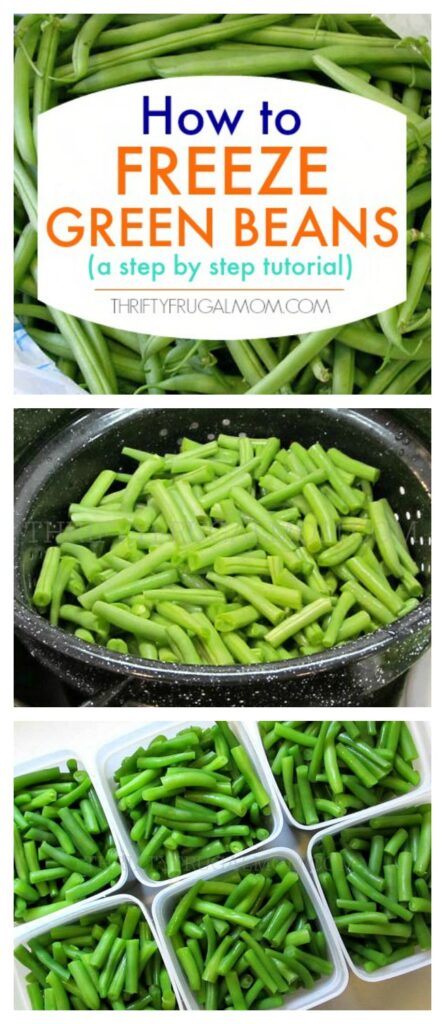


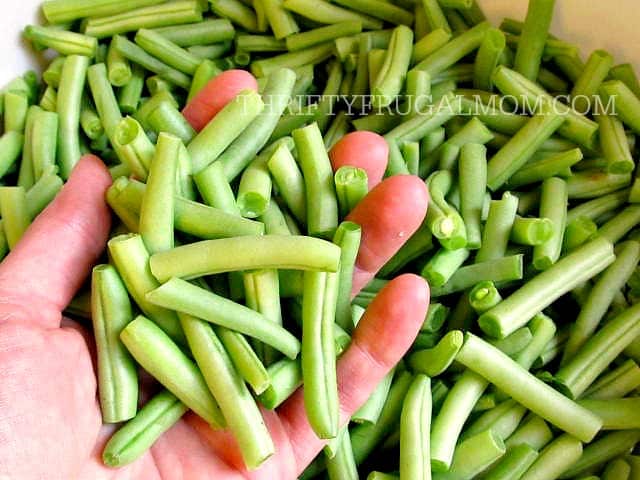

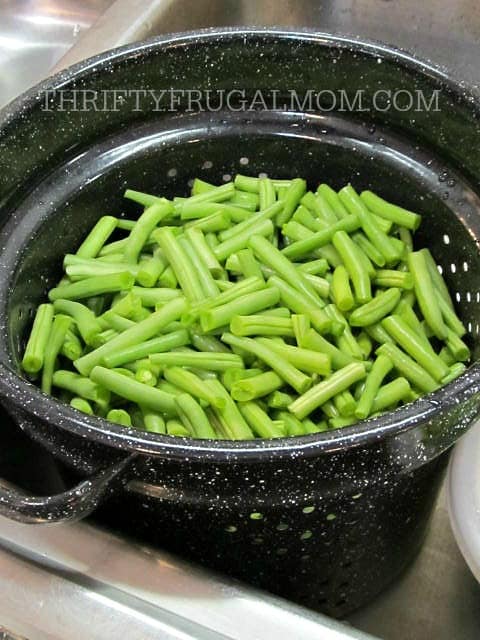
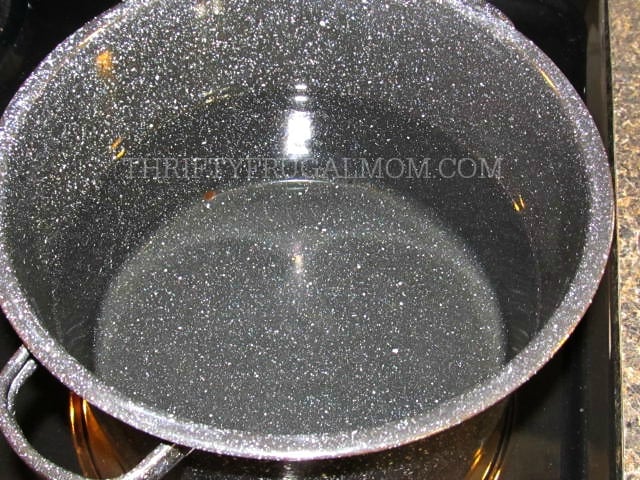
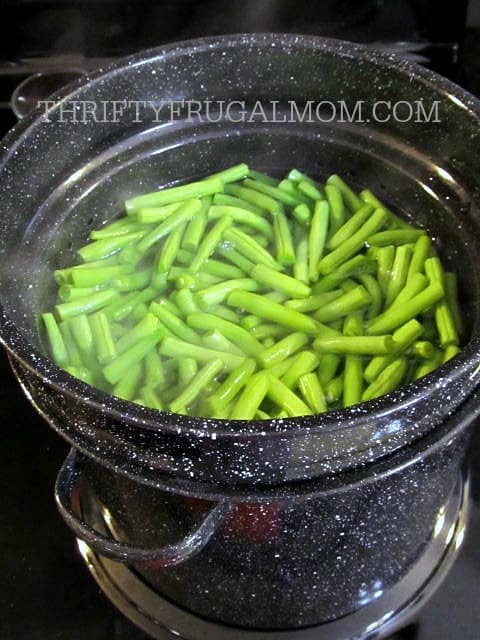



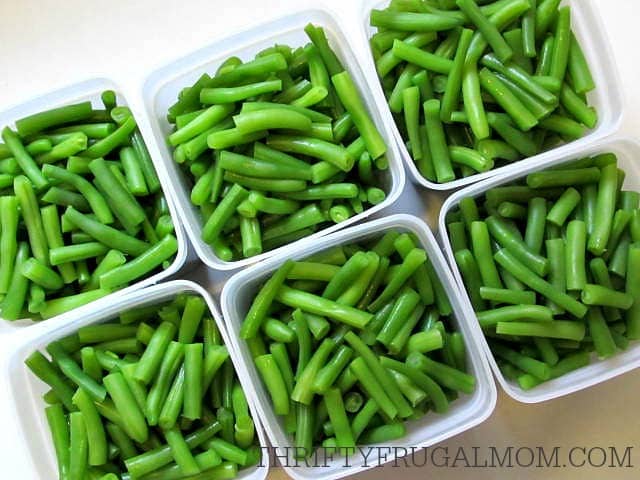


Darrell
I’ve tryed freezing the beans but they come out like rubber don’t know what I’m doing wrong?
ThriftyFrugalMom
Oh dear, that is frustrating! When you froze them, did you follow these instructions exactly or did you do them differently. From my experience, rubbery green beans are typically a result of cooking the green beans enough when you go to cook them in preparation for eating. When you are done the processes that I give here for blanching, the beans will still be very rubbery. So, just like store bought frozen beans, when you get them out of the freezer you need to cook them further. How much depends on your preference and the only way to really tell when they are cooked to you liking is often to taste one.
The other thing that maybe could be the culprit is that the beans were picked too old. But if that’s the case, the beans tend to usually be more stalky and tough, not exactly rubbery.
Hope you can figure out what’s causing it and are able to enjoy some good green beans soon!
Denice Willis
I know when I pressure can my beans I add salt he jar. Do I add any salt when I freeze them?
ThriftyFrugalMom
Yes, when you can produce, adding salt is a good idea. But when you freeze it, it’s recommended to just wait to add the salt until you go to cook the beans.
Izy
Hey just a note that putting any vegetables in hot water should have the water salted. Otherwise there is an osmosis effect which takes the nutrients out of the vegetables and into the water! It will greatly help with the flavor of the vegetables overall!!
Lydia Beiler
Yes, I do this when cooking but have never heard of doing it when blanching veggies. Now I’m trying to figure out if there is any reason not to do it then too!
Barb
I throw a few snack size bags in the freezer for use in homemade veggie soup during the winter. When cooking just the beans I throw in a little bacon grease and bacon pieces. Delicious!!
ThriftyFrugalMom
Love the snack size bag idea! And yes, we love green beans with bacon grease too. So delicious for sure!
Vicki Nash
Why do you blanch them? I cover with water and freeze. Just easier.
ThriftyFrugalMom
Blanching them helps them retain their flavor, nutrition and color. Here’s how the National Center for Home Food Preservation explains it: Blanching (scalding vegetables in boiling water or steam for a short time) is a must for almost all vegetables to be frozen. It stops enzyme actions which can cause loss of flavor, color and texture. Blanching cleanses the surface of dirt and organisms, brightens the color and helps retard loss of vitamins. Hope that helps!
Sandy
How do you cook the green beans when you are in the mood for some?
ThriftyFrugalMom
If I want just plain green beans, I either cook them in my pressure cooker following the instructions that came with that, or else I add about 1 c. water to a pot, add about a qt. of green beans and cook them until they are the tenderness we like, then season them with salt and pepper. They work well in recipes that call for green beans too (BBQ Green Beans etc.) Hope that helps!
Johanna
I like to freeze mine on cookie sheets and put them in large freezer bags after they are frozen. That way I can scoop out the amount I need for smaller meals.
ThriftyFrugalMom
That’s a great idea, Johanna!